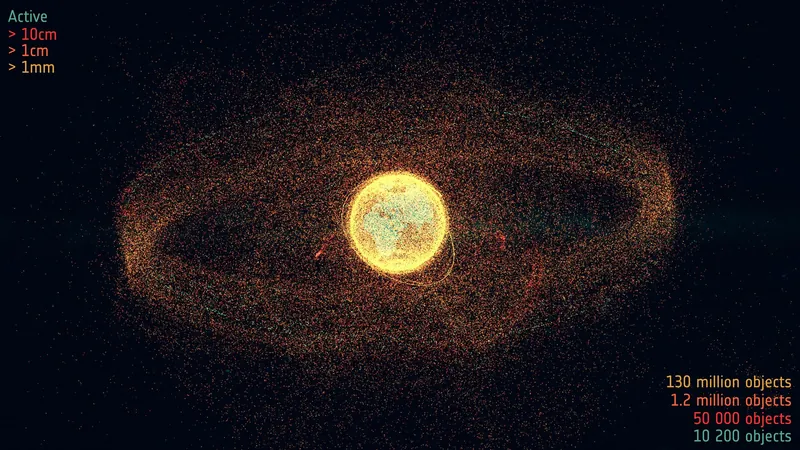
ESA's 2025 Space Environment Report: A Wake-Up Call for the Future of Space Sustainability
2025-04-01
Author: Li
Key Insights from the 2025 Report:
Crowded Orbits: Our low-Earth orbit (LEO) is becoming alarmingly congested. The number of satellites, particularly commercial ones, is escalating year on year, resulting in density levels of active satellites and space debris that are alarmingly similar.
Debris Explosion: ESA's Space Debris Office reported that upwards of 40,000 objects are currently tracked in Earth's orbit, including 11,000 operational satellites. However, the real concern lies in debris, with over 1.2 million objects larger than 1 cm potentially causing catastrophic impacts, and more than 50,000 of those larger than 10 cm.
Collision Risks: On average, intact satellites and rocket bodies now re-enter Earth's atmosphere more than three times a day—signifying a rising number of end-of-life missions yet critically accompanied by insufficient measures for safely removing them from busy orbits.
Growing Threat of Fragmentation: 2024 witnessed notable fragmentation events, adding thousands of new debris pieces that further complicate our already fragile space environment. These incidents highlight the urgent need for improved end-of-life practices, such as passivation to eliminate explosive potential from spent satellites.
Mitigation Efforts and Compliance:
Despite an overall increase in debris, there are positive trends in satellite re-entries. The report indicated a rise in compliance with space debris mitigation standards, particularly among commercial enterprises. ESA's own guidelines now advocate for the removal of rocket bodies within 5 years, a stricter measure that many stakeholders are beginning to adopt.
Rising Re-Entry Rates: In 2024, the number of controlled re-entries of satellites and rocket bodies reached a commendable level. For the first time, controlled re-entries outnumbered the uncontrolled ones, indicating a growing commitment to responsible space stewardship.
Future Outlook: A Call to Action
As the space community looks ahead, preserving the orbital environment becomes paramount. The threat posed by Kessler Syndrome—a critical chain reaction resulting from collisions leading to further fragmentation—looms large. Experts assert that merely halting new launches won't curtail the debris issue. Instead, we need a proactive approach that includes active debris removal and innovative strategies for orbital sustainability.
Human Spaceflight at Risk: The ambitions of space travel are expanding beyond Earth to destinations like the Moon, and even Mars. However, ensuring safe passage through increasingly crowded orbits is crucial for the success of human exploration missions.
What’s Being Done?
ESA has committed to achieving zero debris by 2030, spearheading initiatives such as the 'Zero Debris Charter,' signed by numerous countries and firms. Enhanced tracking systems and stricter guidelines are now being implemented, reflecting a substantial community effort to address the looming debris crisis.
Innovative Solutions: ESA is developing new technologies and capabilities aimed at combatting and preventing space debris. Missions like ClearSpace-1 are underway, dedicated to safely removing existing debris from our orbits.
In Conclusion
The ESA’s 2025 Space Environment Report serves as a poignant reminder that while the stars are calling, the path to sustainable space exploration requires immediate, unified action. The stakes have never been higher, and if we do not act now, we risk losing the very environment that allows humanity to look toward the stars. The time to safeguard our cosmic future is now—will we rise to the challenge?



 Brasil (PT)
Brasil (PT)
 Canada (EN)
Canada (EN)
 Chile (ES)
Chile (ES)
 Česko (CS)
Česko (CS)
 대한민국 (KO)
대한민국 (KO)
 España (ES)
España (ES)
 France (FR)
France (FR)
 Hong Kong (EN)
Hong Kong (EN)
 Italia (IT)
Italia (IT)
 日本 (JA)
日本 (JA)
 Magyarország (HU)
Magyarország (HU)
 Norge (NO)
Norge (NO)
 Polska (PL)
Polska (PL)
 Schweiz (DE)
Schweiz (DE)
 Singapore (EN)
Singapore (EN)
 Sverige (SV)
Sverige (SV)
 Suomi (FI)
Suomi (FI)
 Türkiye (TR)
Türkiye (TR)
 الإمارات العربية المتحدة (AR)
الإمارات العربية المتحدة (AR)